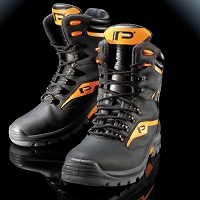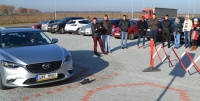It doesn't matter if you are just moving your grandmother's wardrobe, working in the garden, or working in blast furnaces. You should never underestimate the proper protection of your feet.
Let's first talk about what the most common injuries are in the workplace or in the garden:
- stubbing your toe,
- running over your foot (for example, a forklift);spilling hot water or chemicals on the foot,
- danger of slipping (for example, on an icy surface or spilled liquid)
- stepping on a sharp object (such as protruding nails).
All these injuries can happen to you at work, however some can also occur while working around the house or in the garden. From bruises to broken bones. Never underestimate the protection of your feet, as an injured foot will not allow you anything but waiting for recovery.
Long-term injury can also be caused by wearing bad footwear. 1 out of 3 workers who use safety shoes have foot problems. That's why all the shoes we sell go through demanding testing not only regarding protection but also support for the arch of the foot.
What kind of shoes should you choose?
In principle, you have 3 options:
- you can make do with ordinary shoes such as sneakers,
- choose work shoes,
- select safety footwear.
As you care about work safety, of course, you will immediately rule out the first option. Then you have to choose between work and safety shoes. It depends on what you will do. What do the standards say?
Work shoes (without a reinforced toe) are marked by the letter O and meet the requirements of EN ISO 20347. The higher the number after the letter O, the more protective elements the shoe has:
- OB - meets the basic requirements of the standard,
- O1 - OB properties + it has a closed heel area, antistatic properties and absorbs energy in the heel area,
- O2 - O1 properties + prevents water penetration and absorption,
- O3 - O2 properties + are puncture resistant and have a moulded outsole.
Safety shoes (with a reinforced tip) are designated with an S and meet the requirements of EN ISO 20345 standards:
- SB - meets the basic requirements of the standard,
- S1 - SB properties + it has a closed heel area, antistatic properties and absorbs energy in the heel area,
- S2 - S1 properties + prevents water penetration and absorption,
- S3 - S2 properties + are puncture resistant and have a moulded outsole.
- S4 - S3 properties + have antistatic properties and absorb energy in the heel area,
- S5 - S4 properties + are puncture resistant and have a moulded outsole.
The safety shoe withstands pressure of more than 1,500 kg
The safety tip in the shoe can be made of two materials - steel or composite. Many people are afraid that these metal tips can be dangerous to the feet.
It's not true. The tips from the two materials, according to the test, will withstand the force of 200 joules and the pressure of more than 1,500 kg, the advantage of the composite tip is also the lower weight.
But we were wondering if the test scores correspond to practice. That's why we did the test on our own and we put an apple in a bag into a shoe with a safety tip, which we then ran over with a car back and forth.
The result? We removed the apple totally intact.
Everything depends on the soles
You can always choose the sole according to where you work. There are 3 basic categories:
- PU / PU - suitable mainly for indoor use.
- PU / TPU - combination suitable for indoor and outdoor use.
- PU / RUBBER - for extreme use (chemicals, metal shavings, HRO).
Even the finest outsole does not protect you from the cold. If you often work in the cold, go for a insulated shoe - it's labelled with a Flake Symbol and the letters CI (Cold Insulation).
If you're working near a high temperature source, you need an outsole for contact with hot surfaces. These shoes are labelled HRO and, according to the certification, they can withstand a contact with a 300 ° C surface for 1 minute without any signs of damage.
You may need special protection
We also have special shoes for welders and for those who handle large gas cylinders in the assortment - designated with the letter M (metatarsal). They protect against the fall of pressure cylinders on the instep, since the safety tips alone would not prevent the damage of so-called metatarsal bones.
These bones in the instep take a very long time to heal, and they don't heal well. Therefore, M-designated shoes have a composite or steel reinforcement throughout the whole instep. What other special shoes are there and how are they designated?
Trouble free walking is usually taken for granted. Before something happens, let us help you avoid such an annoyance.
































































